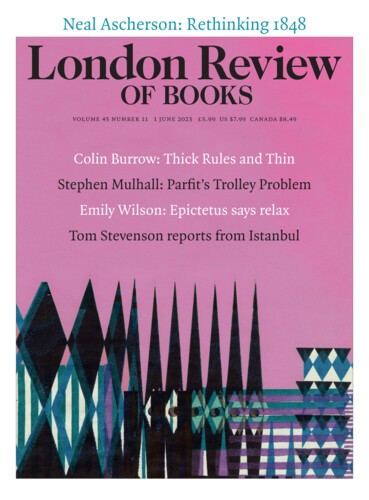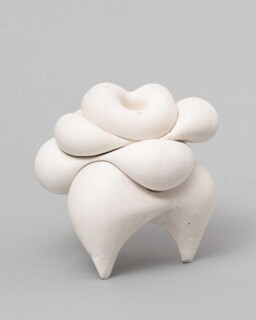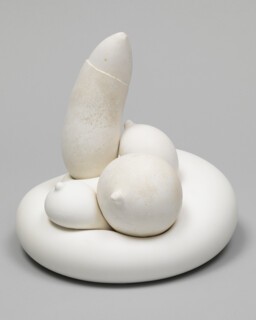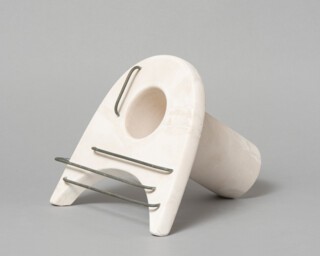The sculptor Mária Bartuszová was born in Prague in 1936 and died sixty years later in Košice, Slovakia, three hundred miles to the east. It was in Košice that her career as a sculptor really began, after she moved, aged 27, to the city with her husband, the artist Juraj Bartusz, and their young daughter. A second child, also a girl, arrived in 1971. In 1984 Bartuszová and Bartusz were divorced. He is still alive at 89.
What these biographical bits and pieces tell us about Bartuszová’s career and work needs teasing out. To read that her diploma submission at the Prague Academy of Arts in 1961 was a set of ceramic vessels offers a first indication that her interests lay squarely in the realm of touch. To encounter her work at the current Tate Modern exhibition (until 25 June) is to see the way that commitment deepened. Of the various aspects of tactility she captured, fragility and fullness are the qualities her sculpture most often brought out.
Bartuszová made around five hundred sculptures, her productivity aided by her preferred material, plaster. The great majority of her works are plaster casts – and not just any sort. Plaster has been used for millennia, but very few pieces have the purity and refinement of surface Bartuszová achieved. She also designed permanent outdoor works, such as the aluminium wall relief at the Southern Slovak Cellulose and Paper Mill in Štúrovo and a second at the Eastern Slovak Steelworks in Košice. The destination of these and other sculptures (one a crematorium, another a school for disabled children) seems to resonate with the fragile tension of her gallery pieces.
Bartuszová generated this tension with a surprising economy of means. Plaster, wire and string were central to her process, provoking sensations in the viewer of pain and pleasure, exclusion and protection. Echoes of breasts and bellies are often summoned, sometimes in arrangements that accentuate their fullness. Other compositions have a different sensuality, weighing down, even interleaving, curving plaster forms with less tractable materials – stone, wood, rubber – as a way of suggesting the sometimes painful play between hard and soft.
If this opposition was one of Bartuszová’s favourite effects, it’s far from the only one she sought. Breakage, bondage, eggs, seeds, vulvas: these forms all figure in her work, often as playful as they are unexpected. She sometimes used condoms, saying she was particularly drawn to the characteristic look – call it nipple-like – of their enclosed end. Bartuszová first thought of using plaster in this way after playing with her two daughters. She began blowing up the girls’ balloons and filling them with wet plaster, a process she called ‘pneumatic casting’. (The American sculptor Charles Ray uses the idea of sculptural pneuma in a parallel way.)
Louise Bourgeois’s early work – the Tate’s 1967 bronze Tits, say – is an obvious comparison. But Bartuszová’s sculpture also has a connection with 21st-century ideas of growth and aliveness. Hers is not the art of a starry-eyed optimist, but it does convey its maker’s sense of life and death as circular. The patterns of the seasons didn’t pass her by. She saw and photographed the rush of a snow-edged brook breaking up in the spring. In 1977 she made a huge travertine sculpture of a single seed grain – ‘huge’ meaning two and a half metres wide.
This was no Dada indulgence: Bartuszová’s marvellous seed was made as part of her work at the Elementary School for Blind and Partially Sighted Children in Levoča, an institution that was, among other things, the site that saw the generation of some of her most experimental – perhaps we should say fruitful – ideas. But Bartuszová wasn’t an isolated do-gooder. Her diary records a list of the sculptors she admired and why:
Brâncuși, Arp and Moore for the perfection of form and the philosophy of their work. Giacometti for the feeling of time and the transience of a human being. Fontana for the simplicity of method and elegant playfulness. De Chirico for the feeling of time stopping, of temporal stillness.
It doesn’t need saying that Bartuszová’s list is the product of a European sensibility. Time, transience and formal allusion are elective affinities: the result here is a sense not of embodiment as such – the shapes in question are only parts, not wholes – but rather of time and gravity on bodily form. From these commitments emerge what may be her most expressive sculptures, a group of teardrop-shaped plaster pendants that resulted from a process she called ‘gravistimulated casting’. It’s not difficult to work out what this means, or why a sculptor so interested in nature should conjure its forces and forms.
The idea of a ‘stimulated’ sculpture did not stop there. Though its effects are only quasi-human, Bartuszová found ways to convey damage, violation and pain. Consider the axe-like stone used to weigh down a three-layered pile of bellying shapes, or the damage wrought on the plaster piece Endless Egg. Sex and suffering are native to her repertoire, but so are splendidly curvaceous collections of bosomy and blossoming shapes. Full or empty, neither condition seemed to give her pause. As for Bartuszová’s viewers, at long last there is a chance to see for oneself.
Send Letters To:
The Editor
London Review of Books,
28 Little Russell Street
London, WC1A 2HN
letters@lrb.co.uk
Please include name, address, and a telephone number.




